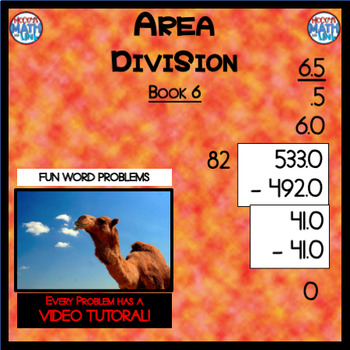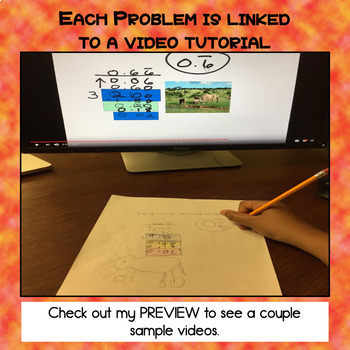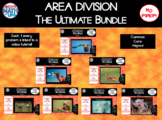Area Division - Book 6 (ie: 533 ÷ 82 = 6.5) (Distance Learning)
- PDF
Also included in
- Bundle DescriptionThis BUNDLE contains all of my books on Area Division. You get the entire series on division at 30% off the price of purchasing each book separately. I use this series for my Math Ninja class. Students in this class are below grade level standards and need a basic understanding ofPrice $24.50Original Price $35.00Save $10.50
Description
Check out a FREE sample of this book on my blog:
http://teachersdungeon.com/blog/long-division-answers-there-is-an-easier-way/
Area Division: Designed so that ANYONE can succeed at long division!
This product is great for anyone struggling with long division. Every division problem is linked to its own video tutorial. NO PREP – Upload to Google Classroom & Go! There are 10 fun word problems and another 16 practice problems for a total of 26 division problems that are linked to their own video tutorials.
Product Breakdown:
§ 10 word Problems
§ 16 Practice Problems
§ All 26 problems that are linked to video tutorials.
After years of watching my 6th graders struggle with the concepts of long division, I decided to create my own method of dividing large numbers. I needed to create a method that was accessible to all children and that made the concepts of division clear and comprehendible. Furthermore, I needed a method that could be used for simplistic problems like 492 ÷ 9, but also higher level problems like 78,369 ÷ 459, and even for dividing decimals like 47.92 ÷ 0.48. Finally, I wanted to create a method that was close enough the long division that students could convert back to long division once they mastered this new method.
I developed Area Division by incorporating skip counting, (I refer to it as “counting by the numbers” in my videos), and an area box for the division. By incorporating counting by the numbers, even students who do not know their multiplication facts can successfully divide large numbers.
· Each book includes over 90 minutes of video tutorials!
WHEN CHILDREN DO NOT KNOW THEIR MULTIPLICATION FACTS…
THEY NEED A STRATEGY!
My goal is for children is to memorize all their multiplication facts. However, until they know all their facts, they need a strategy. Counting by the numbers is the easiest strategy to learn. Therefore, I have added counting by the numbers to the end of each and every video. Children who do not know all their multiplication facts should watch and count with me at the end of each of these videos until they can count by all the numbers on their own. Repetition of this strategy will help in all areas of math that require multiplication. Once a child knows all their multiplication facts, they can stop the videos after the problem is solved and before Counting by the Numbers begins.
There are seven levels in this series on Area Division. I have incorporated a cyclical learning approach, where each educational concept is first introduced, then reinforced, then revisited again and again. Each subsequent level rises to the next level of difficulty.
Area Division is designed to scaffold concepts.
First, Students are introduced to a concept with a “WATCH ME” demonstrational video. After watching the video, students can copy the problem into their math note books, or create a portfolio and copy the notes onto the cover.
Next, students continue developing their skills by working side-by-side with the author, while they watch the “WORK WITH ME” video.
Finally, students perfect their skills by completing a number of problems on their own. After completing each problem, students watch the “ON YOUR OWN” videos. In the videos, they are reminded, “Do NOT worry if you make a mistake. Simply pause the video, and fix your mistake. That is the fastest way to learn.” These last videos teach independence and a deeper understanding of division.
This series can be used in the following ways:
· Intervention for children who have gaps in their learning. I use this series with my 6th graders who still cannot divide. I have had AMAZING results! I start the students on Book 1 and they are able to work independently through the series until they reach grade level proficiency.
· Differentiation – Because there is a video tutorial that accompanies each and every problem, virtually every child in your class can work independently and at their individual level of understanding.
· Extensions for children who need to be challenged.
· Current Content for students that are at grade level, but a little extra support.
· Reinforcement for children who need more to understand this concept.
How to Use this Book:
1. Upload the PowerPoint into your Google Classroom.
2. Have your students access each problem, then correct their own work while watching the video tutorials. Each book within this series links to over 60 minutes of video lessons.
3. After each problem – have your students bring their paper to you.
4. Ask the following questions:
a. Did you use the counting by the numbers?
b. Did complete the problem and then watch the video to check your work?
c. Did you get it correct, or did you find your own mistake and fix it?
d. Did you count along with the counting by the numbers at the end?
5. If your student completes all four of the latter – write something like “FANTASTIC!”, “You are Awesome!”, or “Superb Work My Friend!” on students’ papers - even if they get the problem wrong. As long as they find their mistake and fix it, they are learning. The positive reinforcement statements do wonders for building students’ academic self-confidence.
In the first two chapters of this book, I use Real World Problems (although, I must warn you that my word problems are more fun than real). By solving these word problems, your students will learn how to use Area division to answer any long division problem. The final chapter is titled “Drill & Kill”. In this chapter students drill the skills taught within the book until the kill any mistakes.
Check out my other best sellers
Trouble A Com’n (a series on addition & subtraction)
Trouble A Com’n – Book 1 (3 Digit addition & subtraction - ie- 524 - 365)
Trouble A Com’n – Book 2 (4 Digit addition & subtraction - ie- 5,824 – 2,963)
Trouble A Com’n – Book 3 (adding & subtracting decimals - ie- 36.42 – 29.63)
Area Multiplication
Area Multiplication – Book 1 (2 x 2 Digit - ie- 86 x 97)
Area Multiplication – Book 2 (2 x 3 Digit - ie- 94 x 368)
Area Multiplication – Book 3 (2 x 4 Digit - ie- 37 x 6,375)
Area Multiplication – Book 4 (3 x 4 Digit - ie- 694 x 6,368)
Area Multiplication – Book 5 (Multiplying Decimals - ie- 0.94 x 4.38)
Area Division
Area Division - The ultimate Bundle
Area Division - Book 1 (ie: 524 ÷ 8 = 65 R 4)
Area Division - Book 2 (ie: 4,224 ÷ 8 = 528)
Area Division - Book 3 (ie: 738 ÷ 82 = 9)
Area Division - Book 4 (ie: 2,952 ÷ 82 = 36)
Area Division - Book 5 (ie: 70,864 ÷ 824 = 86)
Area Division with Decimals - Book 6 (ie: 533 ÷ 82 = 6.5)
Area Division with Decimals - Book 7 (ie: 35 ÷ 0.8 = 43.75)
Illustrating Fractions
Illustrating Fractions - The Ultimate Bundle
Illustrating Fractions - Book 1 - Drawing Math Models like 3/7, 4/5, and 8/9
Illustrating Fractions - Book 2: Adding Like Denominators (ie: 5/6 + 4/6)
Illustrating Fractions - Book 3: Subtracting Like Denominators (5/6 - 4/6)
Illustrating Fractions - Book 4: Adding Un-Like Denominators (ie: 2/3 + 3/4)
Illustrating Fractions -Book 5: Subtracting Un-Like Denominators (ie: 2/3 - 1/4)
Illustrating Fractions - Book 6: Adding Mixed Numbers (ie: 1 & 5/6 + 3 & 3/4)
Illustrating Fractions - Book 7: Subtracting Mixed Numbers (3 & 1/4 - 2 & 5/6)
Illustrating Fractions - Book 8: Multiplying Fractions (ie: 6 x 3/5)
Illustrating Fractions - Book 9: Dividing Fractions (ie: 6 ÷ 1/4 and 1/4 ÷ 6 )
Illustrating Fractions - Book 10: Multiplying Fractions (ie: 2/3 x 1/4)
Illustrating Fractions - Book 11: Dividing Fractions (ie: 1/2 ÷ 1/4)
Ratios & Proportions
The Deadly Pit - Using T-Charts to solve ratio & proportions
Get TPT Credit to Use on Future Purchases!
• Please go to your MY PURCHASES page after you log in. Beside each purchase see a PROVIDE FEEDBACK button. Simply click it and you will be taken to a page where you can give a quick rating and leave a short comment for the product. Each time you give feedback, TPT gives you feedback credits that you use to lower the cost of your future purchases.
I value positive feedback and appreciate kind ratings and comments. If you have any issues, questions, or see a small mistake, please email me at brian@teachersdungeon.com, before leaving negative feedback. I will do my best to fix any issues as soon as possible! I really want you to enjoy your purchase and come back to my store for future products.






